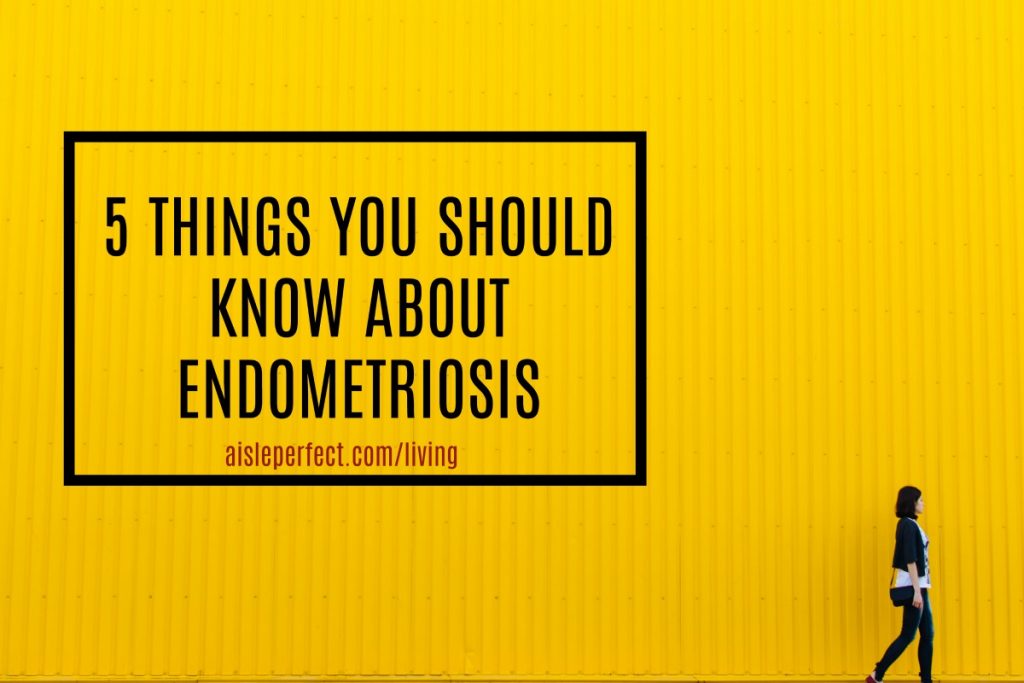
Happy new month! March is Endometriosis Awareness Month. In honor of this, I’ll be sharing a few tidbits over the month about this chronic condition that I live with. If you don’t know my Endometriosis Story, you can read about it here. I am relieved that Endometriosis has been in the news lately, especially with Lena Dunham’s powerful disclosure that she underwent a hysterectomy due to her condition. Even though I’ve dealt with my condition for the last five years, there’s so much I don’t know about the disease so please contact your doctor if you have any concerns. The sooner endometriosis is diagnosed and treated, the better the chances of managing it. So for starters, here’s what to know about endometriosis:
1. What it is:
Endometriosis (En-doe-me-tree-O-sis) is a chronic condition in which tissue that normally lines the inside of your uterus (the endometrium) grows in other places. What this means is that since there’s uterus lining tissue in random areas, you bleed and hurt from these places when your period comes. No one knows for sure what causes endometriosis, but there are a few theories. Some say a backflow of menstrual blood that has settled in the pelvic organs causes it; some say it’s a transformation of cells that line the abdomen into endometrial cells; others say it’s an abnormal transformation of embryonic cells during development. In general, endometriosis is estimated to affect between 3% and 10% of reproductive-aged women. A lot of researchers believe it could be genetic so if a relative of yours suffers from it, you’re five times more likely to have it.
2. Symptoms:
With endometriosis, endometrial tissue can grow anywhere in the body. Because of this, the symptoms of endometriosis can differ from woman to woman. The most popular are:
- severe period pains.*
- Lower abdominal and pelvic pain with or without a period.
- pain with sexual intercourse
- heavy periods
- painful bowel movements or urination (doesn’t necessarily mean endo, could also be a UTI)
- bleeding in between periods ( could indicate growth of a “chocolate cyst” called ‘Endometrioma’ which is caused by menstrual blood backing up into your body).
- Additional symptoms include digestive issues like constipation, nausea or diarrhea.
- Infertility
*note: the severity of your pain or symptoms does not necessarily indicate the severity of your endometriosis. Some women with minor endometriosis may suffer more intense symptoms than those with severe endometriosis.

3. How is it diagnosed?
Although many symptoms may point to it, there’s only one way to 100% diagnose endometriosis- through a laparoscopy. A laparoscopy is a surgical procedure in which a thin telescope-like instrument is inserted through a small incision in the belly button to allow the doctor visualize your abdominal and pelvic organs to identify any growths or abnormalities such as endometriosis, scar tissue, fibroid tumors and more. A laparoscopy will provide more info on the extent of the endometriosis and help the doctor determine the best treatment. Your doctor may order further tests before a laparoscopy to eliminate other causes for your symptoms.
Because laparoscopy is the only way to confirm endometriosis, a lot of women go years without a diagnosis. I, for instance, went ten years without knowing that I had endometriosis. By the time I was diagnosed, it had spread to most of my lower abdomen. If you suspect something isn’t right, make sure you ask your doctor about endometriosis.
4. Complications
Endometriosis can grow damage the fallopian tubes and ovaries. This damage can lead to some pretty severe complications such as:
- Infertility
- Ovarian Endometrioma Cysts
- There’s also a slightly higher risk of ovarian cancer, but it’s still a relatively low chance in general.
5. How to Treat it
There’s, unfortunately, no definite cure for Endometriosis at this time. However, you can manage a lot of the symptoms through surgery and medication. Here are some methods you should know:
- Hormone Therapy: If you’re not trying to get pregnant, this is most likely what the doctor will recommend. You can use Hormonal birth control for an extended cycle (fewer periods in a year) or continuous cycle (no periods) thereby calming the inflammation caused by the rise and fall of estrogen during periods. You can read a more educated description of hormone therapy here.
- Pain Management
- Homeopathic Treatment
- Lifestyle Changes
- Hysterectomy: You may have read about Lena Dunham’s very courageous decision to have a hysterectomy. In severe cases of endometriosis, a total hysterectomy along with the removal of the ovaries may be the best course of action. This decision is, of course, a life-changing one. Make sure you explore this course thoroughly with a medical professional.
So there you have it ladies, my 5 quick facts on endometriosis. Please note that I am not a medical professional or expert so this is for informational purposes only. If you need more information, do your own research and speak to a medically qualified professional for a diagnosis. You can read my personal story here.
























